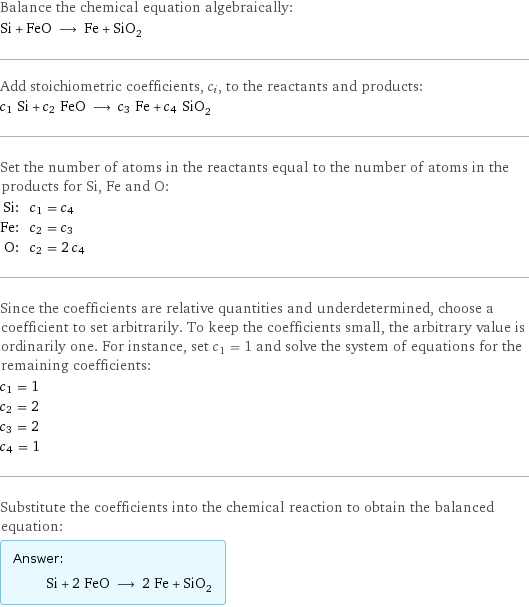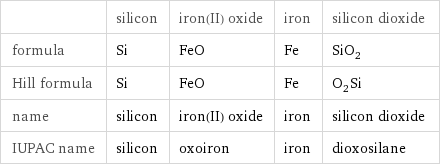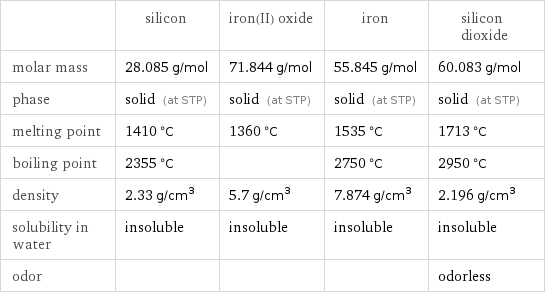Input interpretation

Si silicon + FeO iron(II) oxide ⟶ Fe iron + SiO_2 silicon dioxide
Balanced equation

Balance the chemical equation algebraically: Si + FeO ⟶ Fe + SiO_2 Add stoichiometric coefficients, c_i, to the reactants and products: c_1 Si + c_2 FeO ⟶ c_3 Fe + c_4 SiO_2 Set the number of atoms in the reactants equal to the number of atoms in the products for Si, Fe and O: Si: | c_1 = c_4 Fe: | c_2 = c_3 O: | c_2 = 2 c_4 Since the coefficients are relative quantities and underdetermined, choose a coefficient to set arbitrarily. To keep the coefficients small, the arbitrary value is ordinarily one. For instance, set c_1 = 1 and solve the system of equations for the remaining coefficients: c_1 = 1 c_2 = 2 c_3 = 2 c_4 = 1 Substitute the coefficients into the chemical reaction to obtain the balanced equation: Answer: | | Si + 2 FeO ⟶ 2 Fe + SiO_2
Structures

+ ⟶ +
Names

silicon + iron(II) oxide ⟶ iron + silicon dioxide
Reaction thermodynamics
Enthalpy

| silicon | iron(II) oxide | iron | silicon dioxide molecular enthalpy | 0 kJ/mol | -272 kJ/mol | 0 kJ/mol | -911 kJ/mol total enthalpy | 0 kJ/mol | -544 kJ/mol | 0 kJ/mol | -911 kJ/mol | H_initial = -544 kJ/mol | | H_final = -911 kJ/mol | ΔH_rxn^0 | -911 kJ/mol - -544 kJ/mol = -367 kJ/mol (exothermic) | | |
Equilibrium constant
![Construct the equilibrium constant, K, expression for: Si + FeO ⟶ Fe + SiO_2 Plan: • Balance the chemical equation. • Determine the stoichiometric numbers. • Assemble the activity expression for each chemical species. • Use the activity expressions to build the equilibrium constant expression. Write the balanced chemical equation: Si + 2 FeO ⟶ 2 Fe + SiO_2 Assign stoichiometric numbers, ν_i, using the stoichiometric coefficients, c_i, from the balanced chemical equation in the following manner: ν_i = -c_i for reactants and ν_i = c_i for products: chemical species | c_i | ν_i Si | 1 | -1 FeO | 2 | -2 Fe | 2 | 2 SiO_2 | 1 | 1 Assemble the activity expressions accounting for the state of matter and ν_i: chemical species | c_i | ν_i | activity expression Si | 1 | -1 | ([Si])^(-1) FeO | 2 | -2 | ([FeO])^(-2) Fe | 2 | 2 | ([Fe])^2 SiO_2 | 1 | 1 | [SiO2] The equilibrium constant symbol in the concentration basis is: K_c Mulitply the activity expressions to arrive at the K_c expression: Answer: | | K_c = ([Si])^(-1) ([FeO])^(-2) ([Fe])^2 [SiO2] = (([Fe])^2 [SiO2])/([Si] ([FeO])^2)](../image_source/0c734729dd462a0b2040ca576ff209fb.png)
Construct the equilibrium constant, K, expression for: Si + FeO ⟶ Fe + SiO_2 Plan: • Balance the chemical equation. • Determine the stoichiometric numbers. • Assemble the activity expression for each chemical species. • Use the activity expressions to build the equilibrium constant expression. Write the balanced chemical equation: Si + 2 FeO ⟶ 2 Fe + SiO_2 Assign stoichiometric numbers, ν_i, using the stoichiometric coefficients, c_i, from the balanced chemical equation in the following manner: ν_i = -c_i for reactants and ν_i = c_i for products: chemical species | c_i | ν_i Si | 1 | -1 FeO | 2 | -2 Fe | 2 | 2 SiO_2 | 1 | 1 Assemble the activity expressions accounting for the state of matter and ν_i: chemical species | c_i | ν_i | activity expression Si | 1 | -1 | ([Si])^(-1) FeO | 2 | -2 | ([FeO])^(-2) Fe | 2 | 2 | ([Fe])^2 SiO_2 | 1 | 1 | [SiO2] The equilibrium constant symbol in the concentration basis is: K_c Mulitply the activity expressions to arrive at the K_c expression: Answer: | | K_c = ([Si])^(-1) ([FeO])^(-2) ([Fe])^2 [SiO2] = (([Fe])^2 [SiO2])/([Si] ([FeO])^2)
Rate of reaction
![Construct the rate of reaction expression for: Si + FeO ⟶ Fe + SiO_2 Plan: • Balance the chemical equation. • Determine the stoichiometric numbers. • Assemble the rate term for each chemical species. • Write the rate of reaction expression. Write the balanced chemical equation: Si + 2 FeO ⟶ 2 Fe + SiO_2 Assign stoichiometric numbers, ν_i, using the stoichiometric coefficients, c_i, from the balanced chemical equation in the following manner: ν_i = -c_i for reactants and ν_i = c_i for products: chemical species | c_i | ν_i Si | 1 | -1 FeO | 2 | -2 Fe | 2 | 2 SiO_2 | 1 | 1 The rate term for each chemical species, B_i, is 1/ν_i(Δ[B_i])/(Δt) where [B_i] is the amount concentration and t is time: chemical species | c_i | ν_i | rate term Si | 1 | -1 | -(Δ[Si])/(Δt) FeO | 2 | -2 | -1/2 (Δ[FeO])/(Δt) Fe | 2 | 2 | 1/2 (Δ[Fe])/(Δt) SiO_2 | 1 | 1 | (Δ[SiO2])/(Δt) (for infinitesimal rate of change, replace Δ with d) Set the rate terms equal to each other to arrive at the rate expression: Answer: | | rate = -(Δ[Si])/(Δt) = -1/2 (Δ[FeO])/(Δt) = 1/2 (Δ[Fe])/(Δt) = (Δ[SiO2])/(Δt) (assuming constant volume and no accumulation of intermediates or side products)](../image_source/55ac3f0cf0c6b77cd61b4a951ed98143.png)
Construct the rate of reaction expression for: Si + FeO ⟶ Fe + SiO_2 Plan: • Balance the chemical equation. • Determine the stoichiometric numbers. • Assemble the rate term for each chemical species. • Write the rate of reaction expression. Write the balanced chemical equation: Si + 2 FeO ⟶ 2 Fe + SiO_2 Assign stoichiometric numbers, ν_i, using the stoichiometric coefficients, c_i, from the balanced chemical equation in the following manner: ν_i = -c_i for reactants and ν_i = c_i for products: chemical species | c_i | ν_i Si | 1 | -1 FeO | 2 | -2 Fe | 2 | 2 SiO_2 | 1 | 1 The rate term for each chemical species, B_i, is 1/ν_i(Δ[B_i])/(Δt) where [B_i] is the amount concentration and t is time: chemical species | c_i | ν_i | rate term Si | 1 | -1 | -(Δ[Si])/(Δt) FeO | 2 | -2 | -1/2 (Δ[FeO])/(Δt) Fe | 2 | 2 | 1/2 (Δ[Fe])/(Δt) SiO_2 | 1 | 1 | (Δ[SiO2])/(Δt) (for infinitesimal rate of change, replace Δ with d) Set the rate terms equal to each other to arrive at the rate expression: Answer: | | rate = -(Δ[Si])/(Δt) = -1/2 (Δ[FeO])/(Δt) = 1/2 (Δ[Fe])/(Δt) = (Δ[SiO2])/(Δt) (assuming constant volume and no accumulation of intermediates or side products)
Chemical names and formulas

| silicon | iron(II) oxide | iron | silicon dioxide formula | Si | FeO | Fe | SiO_2 Hill formula | Si | FeO | Fe | O_2Si name | silicon | iron(II) oxide | iron | silicon dioxide IUPAC name | silicon | oxoiron | iron | dioxosilane
Substance properties

| silicon | iron(II) oxide | iron | silicon dioxide molar mass | 28.085 g/mol | 71.844 g/mol | 55.845 g/mol | 60.083 g/mol phase | solid (at STP) | solid (at STP) | solid (at STP) | solid (at STP) melting point | 1410 °C | 1360 °C | 1535 °C | 1713 °C boiling point | 2355 °C | | 2750 °C | 2950 °C density | 2.33 g/cm^3 | 5.7 g/cm^3 | 7.874 g/cm^3 | 2.196 g/cm^3 solubility in water | insoluble | insoluble | insoluble | insoluble odor | | | | odorless
Units
